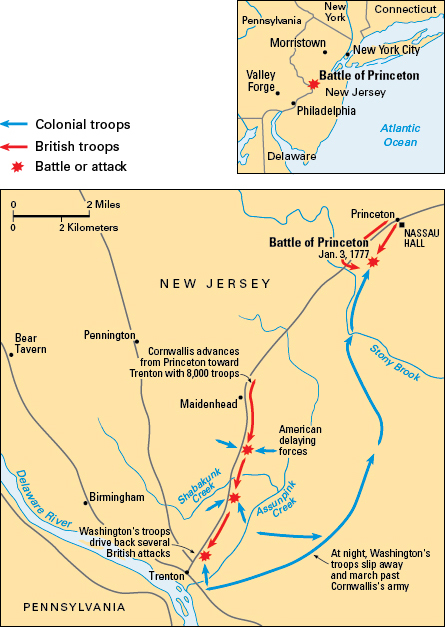Princeton, Battle of, was an important patriot victory in the American Revolution (1775-1783). The battle took place on Jan. 3, 1777, at Princeton, in the colony of New Jersey. Together with a victory at Trenton a week earlier, the battle boosted American hopes in the war. It also allowed General George Washington to rest and rebuild his army during the winter of 1777.

The patriot situation appeared dark at the end of 1776. Washington’s battered forces had withdrawn to New Jersey. In late November, British troops led by Major General Lord Charles Cornwallis poured into New Jersey in pursuit of Washington. The patriots barely escaped to safety by crossing the Delaware River into Pennsylvania on December 7.
Washington’s forces teetered on the brink of collapse. But the British decided to wait until spring to attack. The British set up winter quarters in Trenton, Princeton, and other New Jersey towns. Although Washington had few troops, he decided to strike at Trenton. The town was defended by Hessians––that is, German soldiers hired by the British. On the night of Dec. 25, 1776, Washington and about 2,400 troops crossed the Delaware River. The next morning, they surprised the Hessians at Trenton. They won a key victory and took more than 900 prisoners. After the battle, Washington withdrew his troops to Pennsylvania. He returned to Trenton on December 30. Washington expected a British attack.
On Jan. 2, 1777, Cornwallis advanced from Princeton toward Trenton with 8,000 troops. He was opposed by an American delaying force, but he reached Washington’s army of 6,800 men near dusk. Washington drove back several British attacks, and Cornwallis hoped to finish off the Americans the next day. But during the night, Washington’s troops slipped away and marched past Cornwallis’s army. The following morning, Washington attacked at Princeton.
The first stage of the battle was fought in the fields south of the town. There, the American advance guard met British troops who were on their way to Trenton. The British were on the verge of routing the Americans until Washington arrived with the main part of his army. Washington rallied his troops, forcing the British to retreat. Some British troops retreated to Nassau Hall, on the campus of the College of New Jersey (now Princeton University). According to a popular story, Alexander Hamilton, at that time a captain, fired a cannon into the building, taking the head off a portrait of King George II. The British troops surrendered.
During the Battle of Princeton, about 400 British soldiers were killed, wounded, or captured. The Americans lost about 45 men. After the battle, Washington moved his troops northward to winter headquarters near Morristown, New Jersey. He soon began to rebuild the Continental Army.
